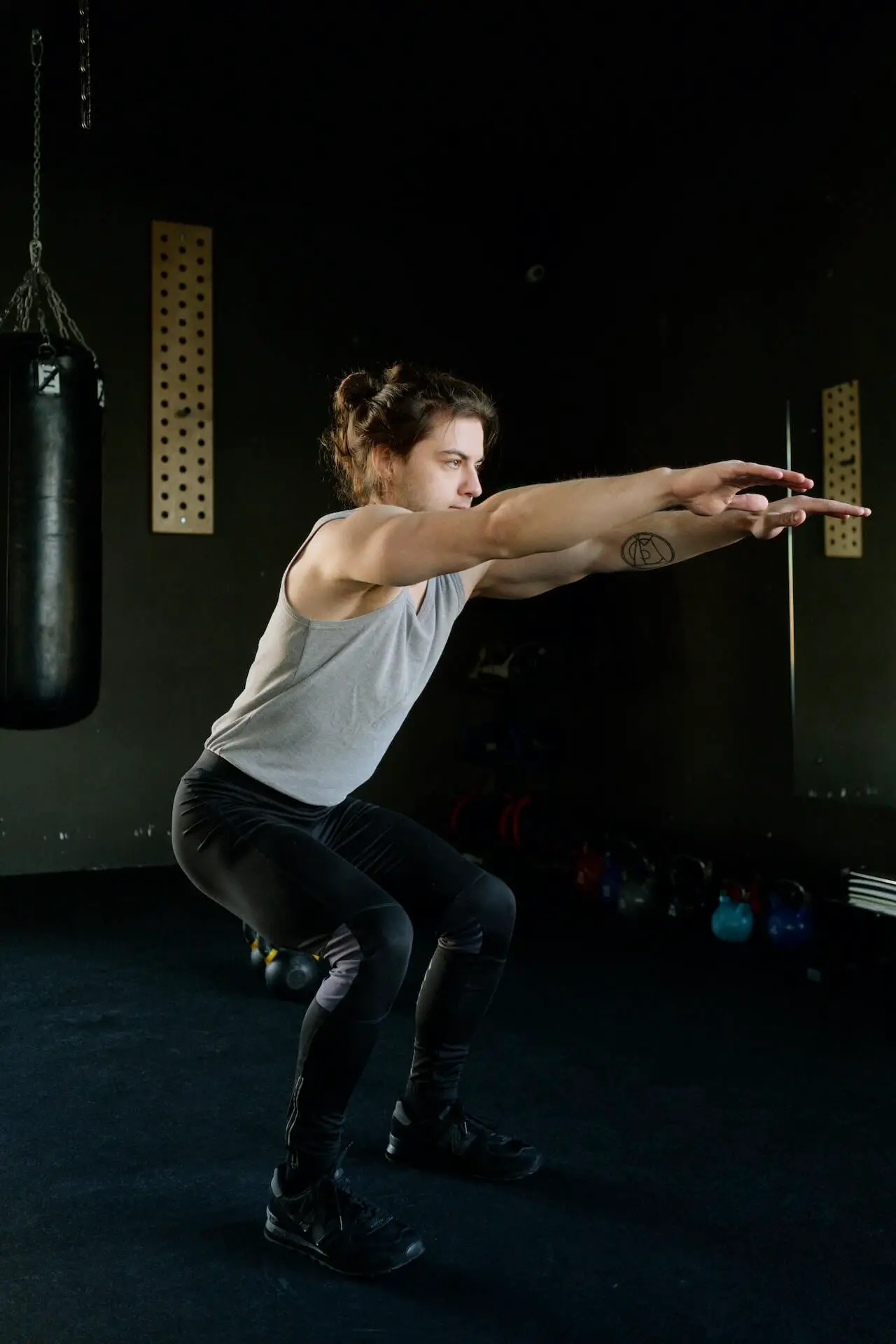Calisthenics has gained popularity among fitness enthusiasts for its ability to build strength, flexibility, and muscular endurance using only bodyweight exercises and minimal to no equipment. But, have you ever wondered if calisthenics are beneficial for swimmers as well?

Yes, incorporating calisthenic exercises into a swimmer’s training routine can improve their swimming performance and overall fitness.By focusing on compound exercises that engage multiple muscle groups, swimmers can effectively improve the power and stability needed for each swimming stroke. Since calisthenic exercises rely on bodyweight, they offer a lower risk of injury compared to traditional weightlifting exercises.
If you’re curious about how exactly calisthenics benefits swimmers and how you can incorporate it into your training routine, then keep reading as we delve into the details below.
Key Takeaways
- Calisthenics can improve strength, flexibility, and endurance, all of which are beneficial for swimming
- Compound, functional exercises in calisthenics help develop the power and stability needed for swimming strokes
- Lower risk of injury with calisthenics due to the use of bodyweight for resistance
Why Swimmers Should Consider Calisthenics
Benefits for Muscle Strength and Endurance
Integrating calisthenics into your dryland workout routine can greatly enhance your muscle strength and endurance.
Unlike traditional weightlifting, calisthenics uses your body weight and focuses on compound exercises, resulting in more functional and dynamic muscle development.
As a swimmer, this means better performance and reduced risk of injury due to improved muscle balance and coordination.
As with all resistance training, you must continually push yourself during your calisthenics workouts by gradually increasing the difficulty and intensity to continually challenge your muscles.
Improving Swimming Technique and Starts and Turns
An important aspect of swimming is mastering your technique, and calisthenics can help with that.
Working on low-impact exercises like push-ups, plank variations, and lunges can translate into improved attention and control over specific movements in the water. Focusing on body awareness and core strength can also help you develop a better sense of coordination.
As a result, your starts and turns can become smoother and more efficient, leading to faster times and overall improvement in your swimming performance.
Low Impact on Joints and Reduced Inflammation
Swimming is already a low-impact sport, but adding calisthenics to your training routine can help further protect your joints from stress and inflammation.
Unlike traditional weightlifting with heavy loads that can place immense stress on your joints, many calisthenics exercises involve slow, controlled movements that minimize the strain on your joints, reducing the risk of injury and inflammation.
As a swimmer, this is particularly important for maintaining healthy and pain-free joints throughout your athletic career.
Support for Aging Swimmers and Heart Rate
For aging swimmers, low-impact calisthenics exercises offer an excellent way to stay fit and maintain cardiovascular health.
Since calisthenics workouts are adaptable to your level of fitness, you can easily modify exercises to suit your needs and continue enjoying the benefits it offers.
Moreover, calisthenics can have a positive impact on your heart rate, which strengthens your overall cardiovascular system and endurance. In this way, incorporating calisthenics into your fitness routine can help you maintain health and swimming performance as you age.
Key Calisthenic Exercises for Swimmers
Calisthenic exercises are a great addition to a swimmer’s workout routine. They strengthen various muscle groups, improve endurance, and increase overall fitness. Here are some essential calisthenic exercises tailored for swimmers.
If you don’t even have access to a gym, then follow the video below to get a fantastic workout with just your bodyweight.
Pull-Ups and Chin-Ups for Back and Arms
Pull-ups and chin-ups are vital exercises for swimmers, as they target the back and arm muscles frequently used during swimming strokes.
By strengthening these muscles, you’ll improve your ability to pull yourself through the water more efficiently.
To perform these exercises, grasp a pull-up bar with an overhand grip (pull-ups) or an underhand grip (chin-ups). Keep your shoulders tucked down, and pull your body up until your chin is in line with the bar. Slowly lower yourself back down and repeat the process.
Planks and Sit-Ups for Core and Abs
A strong core and well-defined abs are crucial for swimmers, as they provide stability and help maintain a streamlined position in the water. Planks and sit-ups are effective at building these muscles.
For a plank, hold your body in a straight line, holding yourself up with your forearms and toes, and engage your core muscles. Hold this position for a set duration.
For sit-ups, lie on your back with your knees bent and feet flat on the ground. Place your hands behind your head and use your abdominal muscles to lift your upper body towards your knees. Slowly lower yourself back down and repeat.
Squats and Lunges for Lower Body
Squats and lunges are excellent exercises for strengthening the lower body muscles, including the glutes, quadriceps, and hamstrings. These muscles contribute to a powerful kick in the pool, leading to improved speed and propulsion.
To perform a squat, stand with your feet shoulder-width apart and lower yourself into a sitting position, keeping your back straight and knees in line with your toes. Slowly rise back up and repeat.
For lunges, step forward with one foot while bending both knees to a 90-degree angle. Push yourself back up to a standing position and switch legs.
Push-Ups and Dips for Chest and Triceps
Push-ups and dips are crucial for targeting the chest and triceps, which are highly used during the push phase of swimming strokes. Incorporating these exercises into your routine can lead to increased strength and more forceful strokes.
For push-ups, position your hands shoulder-width apart, arms at a 45 degree angle, and lower your body until your chest is close to the ground, keeping your arms and back straight. Push yourself back up and repeat.
For dips, place your hands on parallel bars, tuck your shoulders down and back, and lower your body until your upper arms are parallel to the ground, and then push yourself back up.
By incorporating these calisthenic exercises into your workout routine, you’ll strengthen essential muscles, improve your endurance, and ultimately enhance your swimming performance.
Fueling Your Calisthenic Workouts

Proper nutrition plays a significant role in providing your body with the energy needed for calisthenics.
As a swimmer, you should pay attention to your diet, aiming to eat nutrient-dense foods which help fuel your bodyweight workouts and support your swimming performance. A good rule of thumb is to prioritize carbohydrates, lean proteins, and healthy fats.
Carbohydrates provide you with a quick and vital energy source, so you should make sure to consume them around your workout times. Focus on sources like whole grains, fruits, and vegetables.
Lean protein sources such as chicken, fish, or plant-based options like tofu help repair and build muscle tissue.
Finally, don’t forget to include healthy fats like avocados, nuts, and olive oil in your diet, as they aid in the absorption of fat-soluble vitamins and support overall health.
Creating a Personalized Calisthenic Routine
Calisthenics for Different Ages and Fitness Levels
No matter your age or fitness level, calisthenics can be an effective workout for you. As a swimmer, incorporating calisthenics into your training routine can help you improve your strength, flexibility, balance, and coordination.
These bodyweight exercises are easily adaptable to suit your needs – simply adjust the difficulty by modifying the exercise or changing the number of reps.
If you are a beginner, start with basic exercises like push-ups, squats, and lunges, focusing on proper form. As you gain strength and confidence, gradually increase the intensity by exploring more advanced exercises and variations.
For those with more experience, build an even more challenging routine by including exercises like one-arm push-ups, pistol squats, and front levers. Remember, the key is to find the right balance to continue progressing while avoiding injury.
Elements of a Balanced and Challenging Workout
To get the most out of your calisthenic routine, it’s essential to include various types of exercises targeting different muscle groups. Here’s how to develop a well-rounded workout:
- Upper Body: Incorporate push and pull exercises to target your chest, back, and arms. Examples include push-ups, pull-ups, and dips.
- Lower Body: Focus on your legs and glutes with exercises like squats, lunges, and step-ups.
- Core: Strengthen your abs and lower back with exercises such as planks, leg raises, and Russian twists.
- Balance and Coordination: Add movements that challenge your balance and coordination, like single-leg deadlifts or handstands.
- Cardiovascular Health: Improve your cardiovascular endurance by including high-intensity movements like burpees or jumping jacks.
As a swimmer, you already understand the importance of consistency and dedication for achieving your goals. Therefore, integrate your personalized calisthenic routine into your overall training schedule, and aim for 2-3 calisthenics workouts per week for optimal results.
Measuring Progress and Tracking Improvement
Evaluating Swimming Performance Enhancements
If you actually care about making improvements, then you need to keep a detailed log of your workouts and how you are progressing in the short term (i.e. from workout to workout) and in the long-term (i.e. how far you’ve come along compared to when you started).
To track your progress in swimming, it’s essential to measure various metrics that reflect your performance. Keep an eye on your pace, distance, and heart rate to understand your improvements.
As you practice calisthenics, you may notice an increase in swimming speed and endurance. You’ll also want to pay attention to lap splits and stroke count, which can provide valuable insight into your overall efficiency in the pool.
Monitoring Changes in Muscle Strength and Body Position
Incorporating calisthenics into your training routine can help to improve your core and overall muscle strength. You may find that your body position in the water becomes more efficient, streamlined, and balanced.
Here are some ways to track muscle strength and body composition improvements:
- Core strength: Observe how long you can hold a plank, side plank, or perform other core exercises. As your core gets stronger, you should be able to maintain these positions for longer periods.
- Muscle imbalances: Pay attention to any imbalances between your left and right side when performing exercises. Calisthenics can help to address these imbalances, leading to better symmetry in the water.
- Body position: Analyze your streamline position in the water and compare it to when you first started your training. Improvements in body position lead to less drag and better propulsion, ultimately promoting faster swimming.
Remember, while calisthenics can contribute to improving your swimming performance, it’s crucial to combine these exercises with regular pool training to see optimal results.
Your dryland training should complement your swimming, and you should still be focusing most of your efforts on swimming if you want to improve in that area.
Sources:
- https://www.formswim.com/blogs/all/tracking-progress-swimming
- https://www.webmd.com/fitness-exercise/benefits-calisthenics
- https://www.swimmingworldmagazine.com/news/the-options-and-benefits-of-land-workouts-for-swimmers/
- https://blog.arenaswim.com/en/dryland-training/3-dryland-exercises-swimmers-should-avoid/

